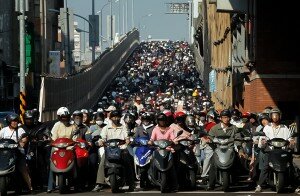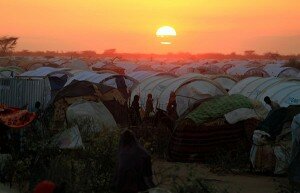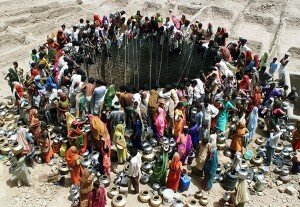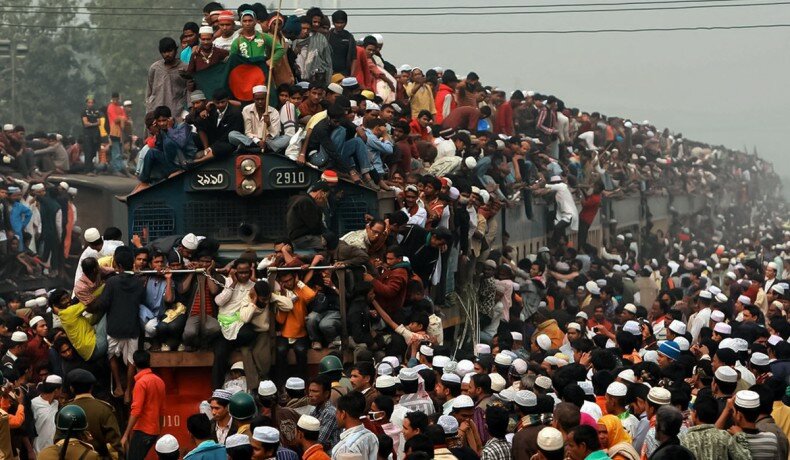By Haroon Janjua –
Several years of research on various global issues, like food insecurity, water issues, climate change, crime and poverty have indicated to a close association between these and the population explosion and distribution of resources
Earth’s population has reached over 7 billion now and increasing 2.3 people every second, according to UN, while US Census Bureau Experts estimates total global population to reach 7.21 billion at the end of 2015. More or less, one in eight persons on earth does not have access to adequate food. How many humans the Earth can accommodate is a continuing question and a serious challenge for demographers and social experts. The situation has become acute with severe problems as an increasing growth rate and rapid consumption cause depletion of natural resources.
Several years of research on various global issues, like food insecurity, water issues, climate change, crime and poverty have indicated to a close association between these and the population explosion and distribution of resources. Keeping in mind the growing population issue, the demographers have started a debate around how we all are connected with these different issues which are getting expanded considerably today, in the midst of new population growth projections.
 According to Food and Agriculture Organization, (FAO) 2014 “The state of Food insecurity in the world” latest available estimates that, “Global hunger reduction continues: about 805 million people are estimated to be chronically undernourished in 2012–14, down more than 100 million over the last decade, and 209 million lower than in 1990–92. In the same period, the prevalence of undernourishment has fallen from 18.7 to 11.3 percent globally and from 23.4 to 13.5 percent for the developing countries.”
According to Food and Agriculture Organization, (FAO) 2014 “The state of Food insecurity in the world” latest available estimates that, “Global hunger reduction continues: about 805 million people are estimated to be chronically undernourished in 2012–14, down more than 100 million over the last decade, and 209 million lower than in 1990–92. In the same period, the prevalence of undernourishment has fallen from 18.7 to 11.3 percent globally and from 23.4 to 13.5 percent for the developing countries.”
Our every act of survival through consumption of its natural resources is seriously impacting the planet’s capability to sustain life. From conversion of timberland into residential areas to destruction of wildlife we are creators of our own destiny. How we can sustain lives depends upon our actions.
There has been a huge development spurt since the previous century or thereabouts. In 1900, demographers pegged the global population at 1.6 billion, in 1950 it was around 2.5 billion, and by 2000 it was more than 6 billion. Presently, there are approximately 7.2 billion people on earth, China, India, USA, Indonesia, Pakistan and Brazil represent a half portion of the world’s people. More than one in three individuals is Chinese or Indian. In recent years we have been adding around a billion individuals each 12 or 13 years, roughly. What numbers of humans exist on the planet at this moment is a matter of debate, contingent upon whom one consults. The United Nations, however, offers the most trusted version of current population figures and patterns.
Despite the fact that more than 800 million people worldwide do not have enough to eat now, the mass starvation Malthus imagined hasn’t happened. This is principally in light of the fact that progress in agriculture including advanced techniques in breeding plants and the use of specialized fertilizers have kept worldwide harvests expanding sufficiently fast to continue with the overall demand. Still, experts such as Jeffrey Sachs and Paul Ehrlich keep on stressing that Malthus may still be correct in the end.
 Ehrlich, a demographic scholar in Stanford University produced a widely acclaimed documentary in 1968 called The Population Bomb, which cautioned of mass starvation in the 1970s and 1980s as a result of overpopulation. Though he definitely missed that date, he keeps cautioning that mankind is heading towards a catastrophe. Ehrlich says the key issue now is the number of individuals on Earth, as well as our over consumption of natural resources, which Elizabeth Kolbert, an American journalist specializing on environmentalism investigated in 2011 in an article called “The Anthropocene—The Age of Man”.
Ehrlich, a demographic scholar in Stanford University produced a widely acclaimed documentary in 1968 called The Population Bomb, which cautioned of mass starvation in the 1970s and 1980s as a result of overpopulation. Though he definitely missed that date, he keeps cautioning that mankind is heading towards a catastrophe. Ehrlich says the key issue now is the number of individuals on Earth, as well as our over consumption of natural resources, which Elizabeth Kolbert, an American journalist specializing on environmentalism investigated in 2011 in an article called “The Anthropocene—The Age of Man”.
Recently Vikram Mansharamani, author of ‘Boombustology’ and lecturer at Yale University, at the recent India Investment Conference compared GDP and population sizes. An advocate of the demographic dividend, Mansharamani focused on Asia and Africa, where population is expected to grow the most. These regions have seen a rising middle class, which is necessary to propel them towards a higher growth trajectory. Twenty years ago, 75% of the world’s consumers were in the developed world, Mansharamani said. Today, that has tilted toward emerging countries by a similar proportion. Based on per capita GDP and population size, Mansharamani identified the “Future 15” economies that will drive the next consumption boom: India, Pakistan, Nigeria, Vietnam, the Philippines, Egypt, Indonesia, Ukraine, Algeria, Thailand, Iran, China, Peru, South Africa, and Colombia. The average per capita GDP of these countries is US$4,100.
As a part of the human dominated period, the past half century has been alluded to as a “Good Acceleration” by Will Steffen at the International Geosphere-Biosphere Program. Other than a near tripling of human population since the end of the World War II, our socio-economic environment has been characterized by human involvement in preparing arable land, damming of waterways, excess water use, development of cropland, expanded utilization of fertilizers, deforestation and more increasing use of fossil fuels. Additionally there has been a sharp rise in the utilization of coal, oil, and gas and a major jump in the production of methane and carbon dioxide which come about because of changes in land usage and over dependence on petrochemicals.
The spiraling population has had a serious impact on the global agriculture industry too. Cultivating enough crops to feed the rapidly increasing world population is posing serious threats and has remained a major and significant challenge. This situation gets to be even more threatening in view of various new projections on future population growth. Where will food for an extra 2 to 3 billion individuals come from when we are scarcely able to sustain even this seven billion? Such questions underscore the real dangers to the eventual fate of worldwide human sustenance.
As environmental changes harm product yields and changing climate conditions upset harvests, producing enough food for our growing populace has ended up what the 2014 World Food Prize Symposium calls “The greatest challenge in human history.”
 Population is not just about head counting of people. Demographers regularly concentrate on three measurements fertility, mortality, and migration when analyzing population patterns. Fertility is about how many children a woman bears in her life time, mortality looks at average life spans, and migration is about where we live and move. Each of these parameters impacts the way our vicinity and effect across the planet.
Population is not just about head counting of people. Demographers regularly concentrate on three measurements fertility, mortality, and migration when analyzing population patterns. Fertility is about how many children a woman bears in her life time, mortality looks at average life spans, and migration is about where we live and move. Each of these parameters impacts the way our vicinity and effect across the planet.
So when we debate about population, it is crucial to additionally examine the effect of how sustainable the population equation is. While new projections of significantly higher world population rates in the decades ahead are cause for concern. The future of agriculture and the ability of the world food system to ensure food security for a growing world population are closely tied to improved stewardship of natural resources. Major reforms and investments are needed in all regions to cope with rising scarcity and degradation of land, water and biodiversity and with the added pressures resulting from rising incomes, climate change and energy demands. There is a need to establish the right incentives to harness agriculture’s environmental services to protect watersheds and biodiversity and to ensure food production using sustainable technologies. We ought to be similarly worried about, and be ready to address, the expanding impacts of resource use and waste.
![]() The writer is a freelance journalist based in Islamabad. He is 2014 International Green Apple Award Winner
The writer is a freelance journalist based in Islamabad. He is 2014 International Green Apple Award Winner































































































